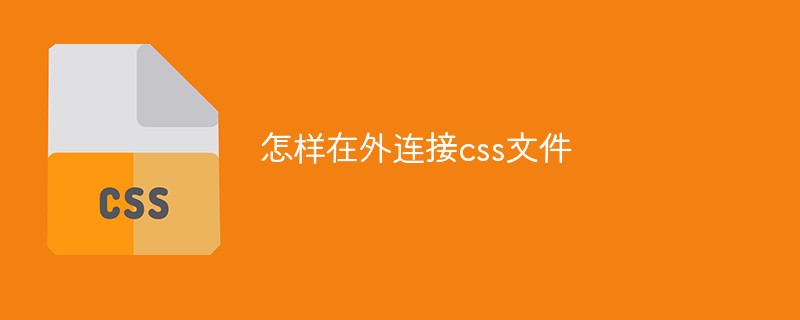How to connect css files externally
How to link external css files: 1. Use the link tag to link to external css files, such as " "; 2. Use the @import rule to import external css files.

The operating environment of this tutorial: windows7 system, HTML5&&CSS3 version, DELL G3 computer.
Recommended: css video tutorial
There are two ways to connect external CSS files
Use the link tag to link external css files
Use @import rules to import external css files
1. Use the link tag Linking external css files (linked)
When styles need to be applied to many pages, external style sheets will be the ideal choice. Using external style sheets, you can change the look of your entire site by changing one file.
Link an external style sheet:
<head> <link rel="stylesheet" type="text/css" href="theme.css" /> </head> <link> 标签定义文档与外部资源的关系。 <link> 标签最常见的用途是链接样式表。
Note: The link element is an empty element, it only contains attributes. The link element can only exist in the head section, but it can appear any number of times.
2. Use @import rules to import external css files (imported)
<style>
@import 'style.css' //Windows IE4/ NS4, Mac OS X IE5, Macintosh IE4/IE5/NS4不识别
@import "style.css" //Windows IE4/ NS4, Macintosh IE4/NS4不识别
@import url(style.css) //Windows NS4, Macintosh NS4不识别
@import url('style.css') //Windows NS4, Mac OS X IE5, Macintosh IE4/IE5/NS4不识别
@import url("style.css") //Windows NS4, Macintosh NS4不识别
</style>The difference between link and import
link is an XHTML tag, except In addition to loading CSS, you can also define other transactions such as RSS; while @import belongs to the category of CSS and can only load CSS; when
link references CSS, it is loaded at the same time when the page is loaded; while @import requires that the page page be completely Load after loading.
link is an XHTML tag and has no compatibility issues; while @import was proposed in CSS2.1 and is not supported by lower version browsers.
ink supports using Javascript to control the DOM to change the style; @import does not support it.
@import can introduce other style sheets into the CSS file; link does not support it.
The above is the detailed content of How to connect css files externally. For more information, please follow other related articles on the PHP Chinese website!

Hot AI Tools

Undresser.AI Undress
AI-powered app for creating realistic nude photos

AI Clothes Remover
Online AI tool for removing clothes from photos.

Undress AI Tool
Undress images for free

Clothoff.io
AI clothes remover

Video Face Swap
Swap faces in any video effortlessly with our completely free AI face swap tool!

Hot Article

Hot Tools

Notepad++7.3.1
Easy-to-use and free code editor

SublimeText3 Chinese version
Chinese version, very easy to use

Zend Studio 13.0.1
Powerful PHP integrated development environment

Dreamweaver CS6
Visual web development tools

SublimeText3 Mac version
God-level code editing software (SublimeText3)

Hot Topics
 1389
1389
 52
52
 The Roles of HTML, CSS, and JavaScript: Core Responsibilities
Apr 08, 2025 pm 07:05 PM
The Roles of HTML, CSS, and JavaScript: Core Responsibilities
Apr 08, 2025 pm 07:05 PM
HTML defines the web structure, CSS is responsible for style and layout, and JavaScript gives dynamic interaction. The three perform their duties in web development and jointly build a colorful website.
 How to use bootstrap in vue
Apr 07, 2025 pm 11:33 PM
How to use bootstrap in vue
Apr 07, 2025 pm 11:33 PM
Using Bootstrap in Vue.js is divided into five steps: Install Bootstrap. Import Bootstrap in main.js. Use the Bootstrap component directly in the template. Optional: Custom style. Optional: Use plug-ins.
 How to write split lines on bootstrap
Apr 07, 2025 pm 03:12 PM
How to write split lines on bootstrap
Apr 07, 2025 pm 03:12 PM
There are two ways to create a Bootstrap split line: using the tag, which creates a horizontal split line. Use the CSS border property to create custom style split lines.
 Understanding HTML, CSS, and JavaScript: A Beginner's Guide
Apr 12, 2025 am 12:02 AM
Understanding HTML, CSS, and JavaScript: A Beginner's Guide
Apr 12, 2025 am 12:02 AM
WebdevelopmentreliesonHTML,CSS,andJavaScript:1)HTMLstructurescontent,2)CSSstylesit,and3)JavaScriptaddsinteractivity,formingthebasisofmodernwebexperiences.
 How to use bootstrap button
Apr 07, 2025 pm 03:09 PM
How to use bootstrap button
Apr 07, 2025 pm 03:09 PM
How to use the Bootstrap button? Introduce Bootstrap CSS to create button elements and add Bootstrap button class to add button text
 How to resize bootstrap
Apr 07, 2025 pm 03:18 PM
How to resize bootstrap
Apr 07, 2025 pm 03:18 PM
To adjust the size of elements in Bootstrap, you can use the dimension class, which includes: adjusting width: .col-, .w-, .mw-adjust height: .h-, .min-h-, .max-h-
 How to set up the framework for bootstrap
Apr 07, 2025 pm 03:27 PM
How to set up the framework for bootstrap
Apr 07, 2025 pm 03:27 PM
To set up the Bootstrap framework, you need to follow these steps: 1. Reference the Bootstrap file via CDN; 2. Download and host the file on your own server; 3. Include the Bootstrap file in HTML; 4. Compile Sass/Less as needed; 5. Import a custom file (optional). Once setup is complete, you can use Bootstrap's grid systems, components, and styles to create responsive websites and applications.
 How to insert pictures on bootstrap
Apr 07, 2025 pm 03:30 PM
How to insert pictures on bootstrap
Apr 07, 2025 pm 03:30 PM
There are several ways to insert images in Bootstrap: insert images directly, using the HTML img tag. With the Bootstrap image component, you can provide responsive images and more styles. Set the image size, use the img-fluid class to make the image adaptable. Set the border, using the img-bordered class. Set the rounded corners and use the img-rounded class. Set the shadow, use the shadow class. Resize and position the image, using CSS style. Using the background image, use the background-image CSS property.




